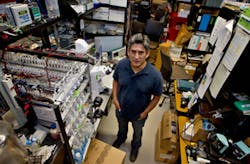Using optogenetics, a Stanford group creates optically triggered heart cells
Palo Alto, CA--A multidisciplinary group at Stanford University has developed human heart cells that can be paced with light via optogenetics.1
Optogenetics allows a light-sensitive protein such as channelrhodopsin-2 (ChR2) or others to be encoded into DNA to produce mammalian tissues that are responsive to light. For the light-responsive heart cells, DNA encoding ChR2 was inserted into human embryonic stem cells. ChR2 controls the flow of electrically charged ions into the cell. For heart cells, the primary ion is sodium, which initiates an electrochemical cascade that causes the cell to contract. The optogenetically engineered stem cells were then transformed into light-sensitive cardiomyocytes.
The genetically engineered form of ChR2 responds strongly to light at a 470 nm wavelength. The result is an influx of electrically charged sodium into the cells, producing a contraction.
Lab-created cells, computer-modeled uses
After creating the cells in a laboratory dish, researcher Oscar Abilez turned to co-researcher Ellen Kuhl, whose specialty is sophisticated computer modeling of the human body. Using her algorithms, they tested the new cells in a computer simulation of the human heart, injecting the light-sensitive cells in various locations in the heart and shining a virtual blue light on them to observe how the injections affected contraction as it moved across the heart.
"In a real heart, the pacemaking cells are on the top of the heart and the contraction radiates down and around the heart," says Kuhl. "With these models we can demonstrate not only that pacing cells with light will work, but also where to best inject cells to produce the optimal contraction pattern."
The long-term goal is a new class of pacemakers to supersede the commonplace surgically implanted electrical pacemakers and defibrillators. "We might, for instance, create a pacemaker that isn't in physical contact with the heart," said Christopher Zarins, another researcher. "Instead of surgically implanting a device that has electrodes poking into the heart, we would inject these engineered light-sensitive cells into the faulty heart and pace them remotely with light, possibly even from outside of the heart."
The leads for such a light-based pacemaker might be placed outside the heart, but inside the pericardium (the protective sack surrounding the heart). Or, a pacemaker could be placed inside the heart chambers (like traditional pacemakers) producing light that would travel through the intervening blood to pace light-sensitive heart cells implanted inside.
REFERENCE:
1. Oscar J. Abilez et al., Biophysical Journal, Vol. 101, No. 6, p. 1326, 21 September 2011.

John Wallace | Senior Technical Editor (1998-2022)
John Wallace was with Laser Focus World for nearly 25 years, retiring in late June 2022. He obtained a bachelor's degree in mechanical engineering and physics at Rutgers University and a master's in optical engineering at the University of Rochester. Before becoming an editor, John worked as an engineer at RCA, Exxon, Eastman Kodak, and GCA Corporation.
